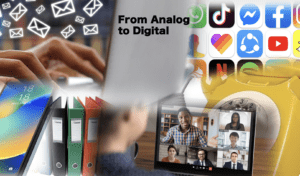The Evolution of the Workplace: From Analog to Digital
The workplace has undergone a dramatic transformation over the past few decades, shifting from an analog environment dominated by landlines and paper to a digital world powered by smartphones and cloud computing. While this transition has brought about significant improvements in efficiency and communication, it has also introduced new challenges and complexities that were unheard of in the analog era.
The Analog Era: Simpler Times, Clear Boundaries
In the analog days, the workplace was a more straightforward environment. Landline telephones, fax machines, and paper memos were the primary tools of communication.
Here are some key characteristics of the analog workplace:
- Defined Work Hours: One of the most cherished aspects of the analog workplace was the clear boundary between work and personal life. Once you left the office, you were effectively unreachable. There were no emails to check or work calls to answer, allowing employees to fully disconnect and recharge.
- Human Interaction: Face-to-face meetings and phone calls were the norm. This fostered strong interpersonal relationships and enabled nuanced communication that is often lost in digital interactions.
- Challenges in Flexibility: Covering shifts on short notice was a significant challenge. With only landline numbers to rely on, reaching out to colleagues was time-consuming and often fruitless. This lack of flexibility could disrupt operations but also limited the expectation of constant availability.
- Physical Documentation: Records were kept in physical files, which required meticulous organisation and storage but also provided a tangible sense of accomplishment and progress.
The Digital Revolution: Efficiency Meets Overwhelm
The introduction of digital technology has revolutionised the workplace, bringing both advantages and drawbacks. Here’s how the modern workplace contrasts with its analog predecessor:
- 24/7 Connectivity: Smartphones and laptops have made it possible to stay connected to work around the clock. While this has increased productivity and allowed for more flexible work arrangements, it has also blurred the lines between work and personal life, leading to burnout and stress.
- Instant Communication: Tools like email, instant messaging, and video conferencing have made communication faster and more efficient. However, the constant barrage of messages can be overwhelming, and the lack of face-to-face interaction can lead to misunderstandings.
- Increased Flexibility: Digital tools have made it easier to manage shifts and find coverage on short notice. Apps and platforms enable real-time updates and scheduling, reducing downtime and improving operational efficiency.
- Digital Documentation: Cloud storage and digital records have replaced physical files, making information more accessible and easier to share. However, this also raises concerns about data security and the potential for information overload.
- Remote Work: Advances in technology have made remote work a viable option for many. This flexibility can improve work-life balance and reduce commuting stress, but it can also lead to feelings of isolation and a lack of team cohesion.
Finding Balance in a Digital World
While the analog workplace had its limitations, it also offered a simplicity and clarity that many now miss. The digital revolution has undoubtedly brought about remarkable advancements in efficiency and flexibility, but it has also introduced new challenges that need to be managed.
As we continue to navigate this digital landscape, it’s essential to find a balance that leverages the benefits of technology while mitigating its downsides. Setting boundaries for connectivity, fostering human interaction, and ensuring data security are all critical steps in creating a sustainable and healthy modern workplace.
In the end, it’s not about longing for the past or rejecting the future but about integrating the best of both worlds to create a workplace that is efficient, connected, and humane.

